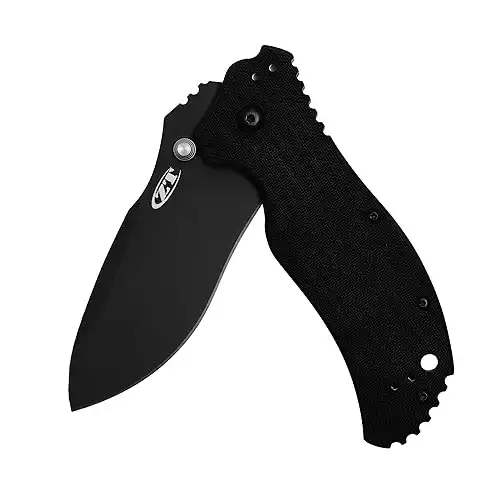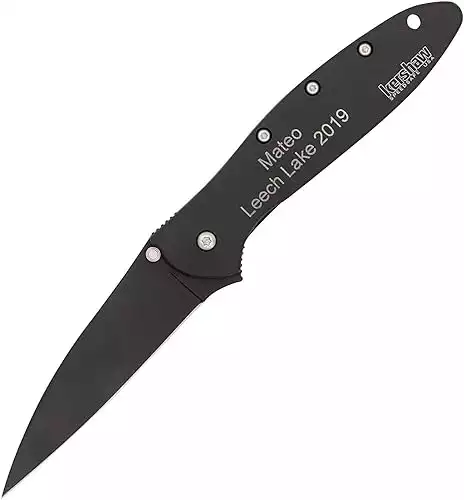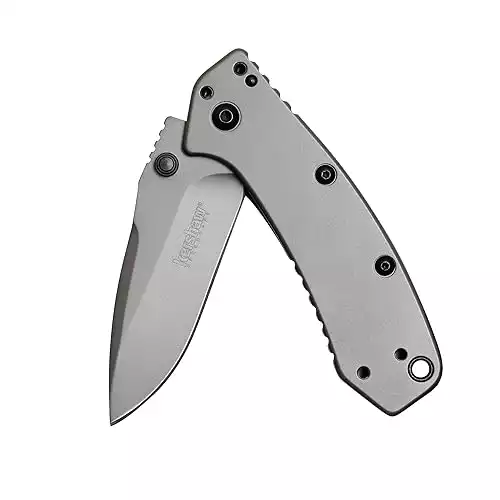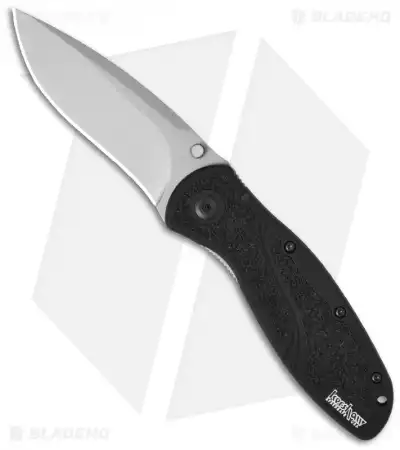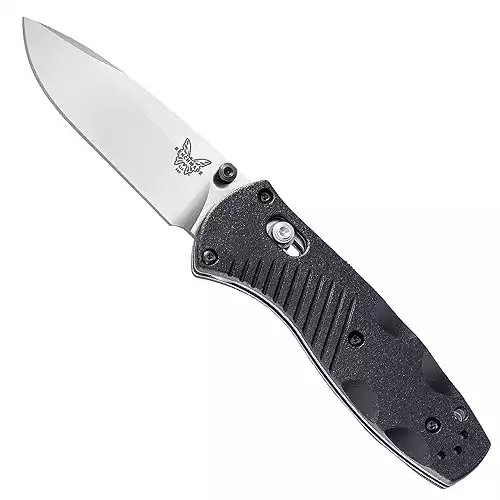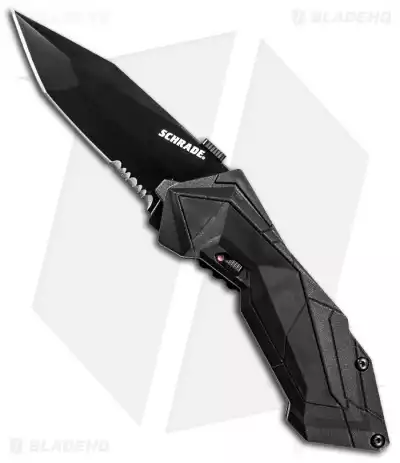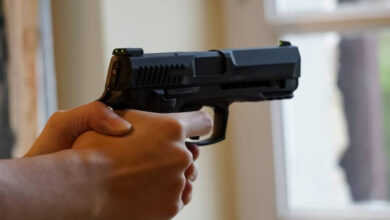8 Best Assisted Opening Knives For Your EDC (Spring and Pocket Options)
You never know where you’ll be when disaster strikes, so having a knife you can carry in your pocket at all times is a good investment.
Assisted opening knives are versatile and are designed for one-handed opening.
This article reviews the best assisted opening knives for general everyday use. If you’re looking for a survival knife, we’d recommend a full tang knife, but folding knives are much more practical to carry around day to day.
If you don’t have your survival gear when disaster strikes, your pocket knife may be all you have.
Let’s get stuck into our top recommendations for the best assisted opening knives.
Our Top Pick
Zero Tolerance 0350 Folding Pocket Knife
ZT is renowned for producing premium quality knives, and the ZT 350 is perhaps their most popular spring-assisted opening knife. The S30V steel offers an excellent balance of edge retention, toughness and corrosion resistance.
The opening systems (flipper and thumb stud) can be operated using either hand, and the pocket clip can be fitted in four different ways to allow for tip-up or tip-down carry in either pocket.
Compared to the other models on our list, it’s a large, chunky knife – it feels solid in your hand but heavy in your pocket.
Blade Length:
3.25 in
Folded Length:
4.63 in
Weight:
6.2 oz
Blade Material:
CPM-S30V
- High-quality steel
- Will keep a sharp edge
- Versatile pocket clip
Best Budget Option
Kershaw Leek
The Kershaw Leek is a popular knife that’s stood the test of time. While most of the knives we’ve reviewed have a drop-point blade, the Leek has a Wharncliffe profile – a sharp tip and long straight edge, which makes it easy to sharpen.
14C28N is a mid-range steel that can be made very sharp. It also uses nitrogen rather than carbon to add hardness, giving the blade a high corrosion resistance. These factors and the slim, lightweight design make it a great value spring-assisted knife.
Folded Length:
4 in
Blade Length:
3 in
Weight:
3.0 oz
Blade Material:
14C28N
- Easy to sharpen
- Corrosion-resistant
- Slim, lightweight design
- Knife tip is a little fragile
- No grip material on the handle – may be slippery when wet
Premium Pick
Zero Tolerance 0770CF
The Zero Tolerance 0770CF is pricey for an EDC knife, but you get what you pay for. In this case, that’s premium CPM-S35VN steel, which is tough, easy to sharpen, and has a razor-sharp edge.
The thin blade and carbon fiber handle make for a slim, lightweight knife that fits easily in your pocket.
The knife fits nicely into either hand and although the flipper mechanism does require a bit of force, it’s fast to open and the locking mechanism is solid. It comes with a reversible pocket clip.
Blade Length:
3.25 in
Folded Length:
4.25 in
Weight:
3.0 oz
Blade Material:
CPM-S35VN
- Premium steel
- Lightweight, stylish design
- Made in the USA
- Pocket clip isn’t of the same quality as the rest of the knife
Lightweight Pick
SOG Twitch II
This sleek knife is a small everyday knife that’s easy (and legal) to carry pretty much anywhere. It features an additional safety lock to keep the blade open or prevent it from accidentally opening in your pocket and a large, sturdy pocket clip.
The blade’s made from AUS-8 stainless steel, a budget steel that is easy to sharpen but doesn’t have great edge retention. The blade is a little on the short side for some tasks, but the size, slim profile and anodized aluminum handle make it look discreet. The spring system may suffer from wear over time.
Blade Length:
2.65 in
Folded Length:
3.55 in
Weight:
2.6 oz
Blade Material:
AUS-8
- Very lightweight
- Good value for money
- Sturdy pocket clip
- Blade is on the short side
- Not as durable as more expensive models
Kershaw Cryo II
Kershaw dominates the EDC market with its high-quality, affordable knives and the Cryo II is one of their most popular blades.
To keep costs down, they’ve used 8CR13MoV steel, but the heat treatment and coating used on the blade help maximize the edge retention and add a bit of hardness that might be lacking in cheaper knives.
You can use the flipper or thumb stud mechanisms to deploy the blade. If you’re willing to put in the work to keep it sharp, the Cryo II is a great value, if rather heavy, pocket knife.
Blade Length:
3.25 in
Folded Length:
4.4 in
Weight:
5.5 oz
Blade Material:
8Cr13MoV
- Flipper and thumb stud options
- Excellent performance for the price
- Good value
Kershaw Blur
The Kershaw Blur has been around for years in various styles. This version has a drop point blade made from high-quality CPM-S30V steel – the same as used in the Zero Tolerance 0350.
It’s not as good looking as the ZT0350 and while the rubberized insert on the handle improves the grip, some people find it gets stuck in your pocket. The ambidextrous thumb stud and Speed Safe technology makes the blade open quickly and smoothly and there’s no risk of accidental opening.
A lightweight, robust knife that should last you for years.
Blade Length:
3.38 in
Folded Length:
4.50 in
Weight:
3.9 oz
Blade Material:
CPM-S30V
- High quality steel
- Rubberized handle gives good grip
- Lots of options for colour and blade type
- Thumb studs can be uncomfortable to use
- Pocket clip is overly tight
Schrade SCHA3 MAGIC
This rather futuristic-looking knife lies at the budget end of the market. Unusually, it has a tanto style blade – designed more for piercing than cutting – with a short serrated section.
The spring-assist system doesn’t require much force for the mechanism to engage, so it’s useful that the SCHA3 has a good solid safety lock to prevent accidental deployment. The rubber grip on the handle makes it comfortable and easy to handle.
Unfortunately, the main downside of this knife is the steel. 4034 is near the bottom end of the market and you’ll have to put in a lot of work to keep the SCHA3 sharp. The clip is also a little too effective – getting it out of your pocket in a hurry can be tough.
Blade Length:
3.00 in
Folded Length:
4.38 in
Weight:
4.9 oz
Blade Material:
4034
- Rubber grip makes it easy to use in the wet
- Solid safety lock
- Fast deployment
- Lower quality steel
- Tight pocket clip
How Do Assisted Opening Knives Work?
Folding knives fall into three categories: manual, assisted and automatic.
With a manual folding knife, you open the blade without assistance from the knife itself. This can make them slow to open or require two hands.
Automatic knives, or switchblades, have a mechanism that forces the blade to spring out of the handle at the push of a button. They’re quick to open but are illegal to carry in many places.
Assisted opening knives cover the middle ground between the two. They require some effort from the user to extract the blade, but once you start, a spring-loaded system kicks in to finish the deployment.
They’re faster and easier to use than a manual folding knife, but the inbuilt mechanism means more parts to break down or jam.
Read more about the different types of survival knife
Are They Legal?
While switchblades are widely prohibited in the US, assisted opening knives can be legally sold and possessed under federal law.
Some states may have specific laws regarding the length of the blade and places where knives are prohibited, such as airports or federal buildings.
Always check the laws in your state or country before buying a spring assisted knife to make sure you’re complying with the law.
Find out more about state-specific laws on the AKTI website.
Important Features
Blade Material
Many different types of steel are used to make knife blades, each with a slightly different blend of toughness, edge retention (its ability to stay sharp), corrosion resistance and ease of sharpening.
Some knife manufacturers try to balance out all these properties to offer a blade with average or above-average scores across the board. Higher-end models tend to prioritize edge retention and toughness. These blades will perform better but will be harder to sharpen.
Your choice will depend on your budget and what you’re planning to use your knife for. For example, if you know you’ll be using it in saltwater, choosing corrosion-resistant steel will be a priority.
You can learn more about common steels used in knife blades on the BladeHQ website.
Blade Length
This comes down to personal preference and what you will likely use the knife for.
Most of the knives we’ve reviewed are EDC knives with blades between 3 and 3.5 inches long. The longer the blade, the bigger the knife on your belt.
Comfort and Grip
How a knife feels in your hand is very personal and difficult to judge when shopping online.
If you’re an experienced knife owner, you’ll already know what you’re looking for, but if this is your first decent knife, it’s worth getting your hands on a few different makes and models to get an idea of what style and size of blade you prefer.
Spring-Assist Mechanism
Assisted opening knives typically use a flipper mechanism or a thumb stud for one-handed opening. A lot of models give the option of both.
One downside of the flipper mechanism is that there’s a risk of the blade being accidentally deployed if something presses on the small fin, for example, when the knife’s in your pocket. For this reason, most knives that use this mechanism have an additional safety lock.
Some knives are designed for use with either hand, but others favor right or left-handed users in the grip design or the positioning of the thumb stud or locking system.
Conclusion
There are plenty of assisted opening knives, and your choice will likely come down primarily to budget and personal preference – how the knife feels in your hand.
Want to know more about survival knives?
Check out our range of knife articles
Read the full article here

